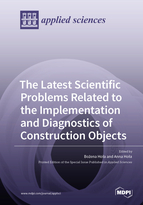The Latest Scientific Problems Related to the Implementation and Diagnostics of Construction Objects
A special issue of Applied Sciences (ISSN 2076-3417). This special issue belongs to the section "Civil Engineering".
Deadline for manuscript submissions: closed (31 December 2020) | Viewed by 57090
Special Issue Editors
Interests: safety and health protection in construction processes; modeling of accidents; phenomenon analysis of the causes of accidents; accident assessment; risks and hazards; construction management; modeling deterministic and probabilistic construction processes; the use of artificial intelligence methods in solving decision problems in construction
Special Issues, Collections and Topics in MDPI journals
Special Issue Information
The construction industry is a sector of the economy that is characterized by a high variability of implementation conditions and a large variety of building structures. In the current period of rapid economic development, this high volatility and diversity generates many new scientific problems that must be solved in order to further improve the quality of production as well as reduce costs and construction time. In addition, in the construction industry, as is the case in other sectors of the economy, great importance is attributed to all ecological activities and broadly understood sustainable development strategies. This means that new building materials, modifications of commonly known and widely used materials, new research methods, and also methodologies for the implementation and control of construction processes are still being sought out. Moreover, the diagnostics of existing objects are gaining importance as the safe use and durability of such objects depend on accurate diagnosis.
We would like to encourage our colleagues to prepare original manuscripts containing current research results and scientific discoveries in the broadly understood field of construction engineering, in particular, referring to research on:
-- How the structure and properties of building materials can be affected by the modification of their composition with various micro- and nanomaterials, byproducts, and also waste;
-- Proposals and the implementation of new methodologies for controlling executive processes;
-- Planning and effective management in the construction industry;
-- Methods for diagnosing building structures, in particular, historical buildings;
-- The demolition of building objects and construction waste management.
To provide an update on the state of knowledge in the field of the above problems and to indicate new directions for future study, we encourage you to submit your latest research results for publication in this Special Issue.
Prof. Dr. Bożena Hoła
Dr. Anna Hoła
Guest Editors
Manuscript Submission Information
Manuscripts should be submitted online at www.mdpi.com by registering and logging in to this website. Once you are registered, click here to go to the submission form. Manuscripts can be submitted until the deadline. All submissions that pass pre-check are peer-reviewed. Accepted papers will be published continuously in the journal (as soon as accepted) and will be listed together on the special issue website. Research articles, review articles as well as short communications are invited. For planned papers, a title and short abstract (about 100 words) can be sent to the Editorial Office for announcement on this website.
Submitted manuscripts should not have been published previously, nor be under consideration for publication elsewhere (except conference proceedings papers). All manuscripts are thoroughly refereed through a single-blind peer-review process. A guide for authors and other relevant information for submission of manuscripts is available on the Instructions for Authors page. Applied Sciences is an international peer-reviewed open access semimonthly journal published by MDPI.
Please visit the Instructions for Authors page before submitting a manuscript. The Article Processing Charge (APC) for publication in this open access journal is 2400 CHF (Swiss Francs). Submitted papers should be well formatted and use good English. Authors may use MDPI's English editing service prior to publication or during author revisions.
Keywords
- construction industry
- scientific problems
- sustainable development
- implementation
- management
- diagnostic of building structures
- diagnostic methods
- modification of building materials
- construction waste management
- safety management
- controlling executive processes






